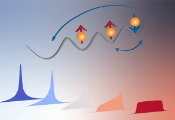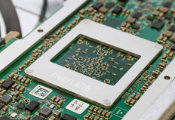Protecting Expressive Circuits with a Quantum Error Detection Code
January 8, 2024 -- Detecting and correcting errors has become a critical area of development in quantum computing, a key that will unlock results which put quantum computers in a different league from their classical counterparts. Researchers are working on ways to handle errors so that the hardware we will have in the coming months will be capable of performing useful tasks that are intractable for any classical computer — in other words, to achieve “quantum advantage”.
The full monty, known as “large-scale fault-tolerant quantum error correction” remains an open challenge in the quantum computing landscape, placing incredibly demanding constraints on the hardware. A promising start is to implement error detection instead of full error correction. In this approach, the system regularly checks for errors, and if one is detected, throws out the computation and restarts.
The team at Quantinuum realized that just such a code, nicknamed the “iceberg code”, if optimized to take advantage of the industry-leading components in Quantinuum’s trapped-ion quantum computers, could offer real potential for early fault-tolerance. Quantinuum’s H-Series hardware boasts mobile qubits, mid circuit measurement and the ability to program circuits with arbitrary-angle gates – making it ripe for new algorithm implementation and development.
The team’s results, published today in Nature Physics Protecting expressive circuits with a quantum error detection code, detail a code that’s so efficient it was able to protect much deeper and more expressive circuits than had previously been realized with quantum error correction, and it did so making extremely efficient use of the very high-fidelity qubits and gates available in Quantinuum’s quantum charge-coupled device (QCCD) architecture.
A key advantage of the iceberg code is how efficiently it squeezes out the maximum number of logical qubits from the given set of physical qubits – it can make k logical qubits out of only k+2 physical qubits. Every logical gate is implemented by a unique two-qubit physical gate, making it a very fast, clean, and expressive implementation. In addition to this, it needs only 2 more ancilla qubits for syndrome measurement, making for a very small overhead of only 4 physical qubits. Using the original 12-qubit configuration of Quantinuum’s H1-2 computer (since increased to 20), this meant the team could realize 8 logical qubits.
With these 8 logical qubits, the team implemented much deeper and more expressive circuits than had previously been demonstrated with quantum error correction codes. The team’s work is the first experimental demonstration that sophisticated quantum error detection techniques are useful to successfully protect very expressive circuits on a real quantum computer. In contrast, previous demonstrations of fully fault-tolerant codes on hardware showed protection only of basic logical gates or “primitives” (the building blocks of full algorithms).
The Iceberg code is a method that’s useful today for practitioners, and can be used to protect near-term algorithms like the ‘quantum approximate optimization algorithm’, or the ‘variational quantum eigensolver’, algorithms currently put to work in domains including chemical simulation, quantum machine learning and financial optimization. In fact, it was used by a team at Quantinuum to protect the quantum phase estimation algorithm, a critical piece for many other quantum algorithms, and deployed in a state-of-the-art simulation of a real-world hydrogen molecule using logically-encoded qubits — a feat not possible using any other quantum computing hardware yet developed.
Looking forwards, the team plans to push the code as far as possible to determine if it is sufficient to protect quantum circuits capable of a quantum advantage. This will require setting a “minimal” quantum advantage experiment, working on careful engineering and benchmarking of every aspect of the code, and the use of Quantinuum’s best-in-class high fidelity gates. In parallel, they will also be working to understand if and how the Iceberg code can contribute to minimize the resource overhead of some of the most promising fully fault-tolerant codes.




































